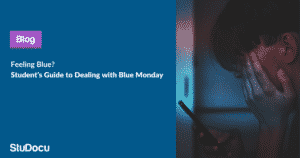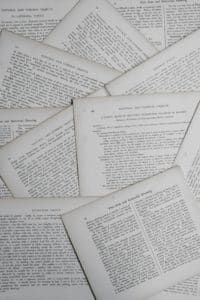Outline Note Taking Method 101 - Everything You Need To Know
An outline could be a sketch or a drawing. It could be a simple framework for a novelist or a screenwriter. Sometimes they are called syllabuses or topic maps.
All these examples include general descriptions of one topic or another. They summarize essential points in lectures, books, and ideas.
Outline note taking methods serve many purposes, and they are perfect for students who want the best tools at their disposal to study more efficiently.
Below we will explore all there is to know about outline note taking. You’ll also learn where note taking began, why the outline note taking method is so effective, and much more.
A Brief History of Note Taking
Note taking has been pivotal to societal advancement ever since writing’s invention.
Ancient clerics carved their notes into wax tablets and scribbled them onto sheets of papyrus paper. Like record-keeping, note taking was probably one of the earliest forms of writing.
Mesopotamians made notches in stones to keep track of trade and storage, and some of their ancient note taking tablets survive today.
In ancient Rome, the legendary philosopher Pliny the Elder was a prodigious note taker. He took down notes on every single book he’d ever read. Pliny left behind 160 volumes of these notes after his death.
During the Renaissance, note taking grew beyond scholars and philosophers. Soon, the aristocrats of Europe caught onto the art of note taking. Miraculously, many note collections from this period still exist in the modern world.
As time wore on and our societies began to take shape, note taking became an integral part of academia. In the modern world, students of all ages and disciplines take notes on lectures, reading assignments, and even videos on the internet.
Why Note Taking Works
Learning a new subject or skill can be incredibly difficult. Proving you comprehend this information can be even more so.
Acquiring knowledge is just the first step. Once you come in contact with the new information, you must effectively remember it for later use. Humans have several different memory types; long-term, short-term, and sensory.
All three work together to ensure the right information sticks around in your head. Long-term memory is the best way to ensure you don’t forget, and note taking helps us use our long-term memory capabilities in many ways.
Taking notes vastly increases our ability to learn and remember the things we have already learned. It helps you comprehend the complicated subject matter. Most of all, it helps our minds effectively organize information.
Note taking provides us with a chance to compare what we learn with what knowledge we already possess. It also helps us to store information using an outside source.
This information is easily accessible later if it’s forgotten.
While it’s beneficial to take notes of any kind when you study, in most cases, handwritten notes will help you remember better than typing them out on a computer.
Specific Note Taking Methods
Note taking is an essential study resource that students of all stripes use to integrate new information.
While taking notes might seem like an intuitive process, there are various methods you can follow to get the most out of your note taking experiences.
Aside from outline note taking, there are four other common note taking methods you can pick.
Mapping Method
The mapping method is a graphic representation of whatever content you are studying.
When you use the mapping method, you utilize the concentration and comprehension skills that relate separate facts and ideas to each other. Mapping calls for active and precise participation and emphasizes critical thinking.
It is a good strategy for visually tracking whatever information you need to learn, and it is easy to see how topics relate to each other in this visual format. If the subject or materials you are studying or listening to are well-organized and dense, mapping is an effective way to take notes.
Cornell Method
Choosing the Cornell method can help you condense and organize your notes without the frustration and hassle of recopying them.
You use the right part of your paper to take notes. Then use the left-hand margin to label your ideas using keywords and cues. You use these cues to signify pertinent information you want to remember.
It is one of the most organized note taking methods available, and it works very well when taking notes on lectures.
Sentence Method
The sentence method works much like it sounds. You simply write a new sentence for every topic or fact presented. You can number your sentences as your notes progress.
This method is more organized than simply writing down long paragraphs of notes, but it is much less organized than other note taking strategies.
Using the sentence method is tricky to use because it’s harder to discern between major and minor points in the sequence. It can also be a pain to rewrite once you decide you need a different organizational strategy.
It works best if you know how to write in an understandable shorthand. The sentence note taking method is very beneficial if you need to take notes on a fast-moving lecture.
Charting Method
When you listen to a lecture or study materials in chronological order, the charting method is a failsafe strategy for note taking.
To use the charting method, you draw columns and use labels for headings in a table. You should first decide what main categories will be covered and set up your notes in advance with categorized columns.
While you listen or study, record the ideas, words, or phrases you hear and see into the correct category.
This method helps you keep track of spoken or written information that might confuse you. It reduces the amount of writing you’re responsible for and helps students memorize complex facts.
Learning to use the charting method can be frustrating compared to other methods. It is a perfect method for students who want to cut down on note editing and prefers to see the full scope of the material as they study.
The Outline Note Taking Method
The last of the most common note taking strategies is outline note taking. It’s one of the most effective note taking methods, and one of the most common methods college students use.
Outlines help organize important information in a logical, structured form. It creates a barebones overview of reading material or a spoken lecture that provides a top-notch study guide for students.
You can use the outline method for most subjects, and it is so easy to learn. However, outlines are not the best idea when studying STEM subjects like math or physics. To use outlines effectively, you need to identify the structure of the material you’re trying to learn. There are various outline method of note taking pros and cons, but how they apply to you depends on your requirements.
What Is the Outline Note Taking Method?
Here is an outline method of note taking example that is easy to understand and adopt.
You begin with the most general information on the left. With each new category, you indent with spaces or characters.
Outline notes are hierarchical and allow you to effectively record what you are studying by delineating different categories within any subject.
How To Use the Outline Method
While reading or listening to a lesson, you will record what you’re learning in a pattern based on indentation.
Start by positioning the most topical points to the far left. As you go, simply indent specific information to the right. You can signify the importance of your topics using the distance from the major categories in your outline.
You can use spaces, or you can also use decimals, Roman numerals, dashes, bullet points, or letters to indicate the importance of each idea as it relates to an overarching theme.
Once you finish your notes, it’s a good idea to reread them and edit anything that confuses you or doesn’t make sense. Do this while the information is still fresh in your mind for the best results.
Using the margins of your note to add pictures and diagrams may be helpful.
This clear hierarchy of information creates a logical structure in your notes so you can identify the importance of each piece of information you record. If you have never used this method before, you should try practicing it first. You can use a textbook at home to get a better idea of how this note taking system works.
When To Use the Outline Method
Using the outline format works best when you have time to think about the necessary organizational structure of your notes.
It’s most effective in traditional class settings where lessons or subjects get taught in a highly structured manner. The outline note taking method can be tough to construct at first, but a well-organized structure helps you tackle logical and progressive subjects.
If you are a self-motivated learner, you might find that the outline method works better than other note taking approaches.
Advantages of Using an Outline
If used correctly, one of the main advantages of the outline method of note taking is that it records content and helps you keep track of how different topics relate to each other. Outlines are easy to review and cut down on editing when you turn the main points into questions.
When dealing with highly structured lessons or lectures, the outline method provides a handy way of quickly organizing lots of information.
While outlining may be a basic form of notetaking, its structure helps facilitate local coherence. This allows you to retain information neatly and logically. Outlines make information retrieval much more manageable, and your mind uses that information to build internal connections, which leads to better knowledge retention.
Disadvantages of Using the Outline Method
The outline note taking method requires lots of concentration and hands-on thinking. Without these things, you can’t accurately organize all the essential ideas in the lesson or lecture.
If the information you need to learn gets delivered too quickly, the outline method may not be a viable option.
An outline is not the most creative note taking system, and this method can be challenging to use for some students. It may be impossible to denote all the connections with an outline in more hands-on classes, such as STEM subjects.
Frequently Asked Questions
It can be a bit discombobulating to try and find the right note taking method for your unique learning needs.
If you still have questions concerning this note taking technique, you can find some helpful FAQs below to help clear things up.
Why is the Outline Method Important?
The key to a successful study strategy is finding an effective way to quantify and retain critical information.
Outlining the topics that you need to learn can help you do both and keep the subject matter highly organized for future study sessions.
An outline helps you organize and construct many different ideas under a large umbrella topic. The sequential flow allows students to pinpoint relevant information quickly.
It is an excellent way to foster practical memorization skills for various topics and subjects.
How Do You Study With an Outline?
Once you have finished your outline and made any necessary revisions, you can use it to study the information you wish to learn effectively.
Start your studying by reading through each line of text one at a time. Attempt to explain the information to yourself in a logical manner, drawing on what you learned when you took the notes initially.
As you read, be sure to connect your ideas throughout your notes. You can add cues or clues to help you make connections or prompt instant recall of pertinent information. Use your own words to write a summary of the information and how it connects the main points throughout the outline.
What Are Some Helpful Note Taking Strategies?
No matter what note taking method you choose, some time-honored techniques will help you get the most out of your notes every time.
Develop a Shorthand System
Unless you can write with superhuman speed, most of the time, you will not be able to write every single piece of information down. If you are creating an outline to study written information, taking thorough notes is easier.
Even so, you want to use your time efficiently, and using shorthand phrases can cut a lot of time out of your note taking, especially when it comes to lectures.
Better yet, using understandable shorthand to write up headline information and key terms comes in handy in many other practices besides studying.
No one is going to grade you on spelling and proper grammar in your notes, so don’t get caught up on etiquette. As long as you can understand what you write, you will be fine.
Utilize Symbols and Images
If it helps you take better notes, don’t be afraid to use drawings, symbols, and icons to aid in your note taking.
Some students retain information better using visual aids. You can also utilize highlighters or different color pens to help you separate information as needed.
Dating Your Notes
Putting accurate dates on your notes makes reviewing them easier. It is also helpful for grounding your mind in the present moment as you study.
Chronological organization of your notes is a great strategy when you are learning lots of information on subjects that might take several lessons to finish.
Dating your notes allows for quick reference when you need a refresher. Reminding yourself when you took the notes helps add more context to your notes and interpret your thought process at the time.
Know Your Instructor
Learning your teacher’s instruction style is paramount to taking good notes.
They won’t include every last detail in tests and projects. Some instructors swear by class notes, and others are less concerned about them in the long run.
Knowing how your teacher expects you to use the information you’re learning will help you take the best notes possible.
Review and Revise
Revising and reviewing your notes right after taking them is a surefire way to retain the information you need.
It’s best to review your notes several times before taking a test so you are not trying to cram all your learning at once.
Study your outline for 10 to 20 minutes daily, and you will successfully integrate even the most complicated subjects.
Does Note Taking Improve Learning?
Note taking helps keep you sharp and focused when you are learning or studying. You are actively engaging with the topic by listening or reading, then summarizing what you have learned.
Doing this will help you better understand the material and remember it with ease. Learning how to take good notes is a skill that will make your academic life easier in every capacity.
The Final Word
When you are trying to process and integrate new information, choosing a reliable, organized note taking method is paramount.
The outlining note taking method is a wonderful way to keep a concise record of your studies. It breaks down even the most complex topics to help you isolate the most important points and subpoints.
This consistent note taking structure is easy to use, share, and review. Students from all walks of life can benefit from learning how to use the outline note taking method.
The outlining method forces you to put more effort into memorizing important information in a short time and helps you expand your mind in a practical, highly organized manner.






